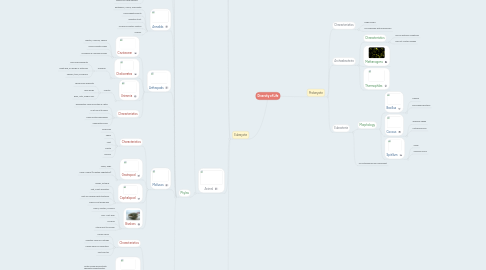
1. Prokaryote
1.1. Characteristics
1.1.1. Single celled
1.1.2. No organelles with membranes
1.2. Archaebacteria
1.2.1. Characteristics
1.2.1.1. Lives in extreme conditions
1.2.1.2. May not contain oxygen
1.2.2. Methanogens
1.2.3. Thermophiles
1.3. Eubacteria
1.3.1. Morphology
1.3.1.1. Bacillus
1.3.1.1.1. Cholera
1.3.1.1.2. Rod shaped bacteria
1.3.1.2. Coccus
1.3.1.2.1. Spherical shape
1.3.1.2.2. Lactobacillus sp.
1.3.1.3. Spirillum
1.3.1.3.1. Spiral
1.3.1.3.2. Spirillum minus
1.3.2. No mitochondria nor chloroplast
2. Eukaryote
2.1. Fungi
2.1.1. Characteristics
2.1.1.1. Must absorb energy
2.1.1.2. Reproduce through spores
2.1.1.3. Sexual & Asexual
2.1.1.4. Not motile
2.1.1.5. Cell walls composed of chitin
2.1.2. Phylas
2.1.2.1. Zygomycota
2.1.2.1.1. Common Mould
2.1.2.2. Ascomycota
2.1.2.2.1. Yeast, Truffles, Morels
2.1.2.3. Basidiomycota
2.1.2.3.1. Mushrooms, Club Fungi
2.1.2.4. Deuteromycota
2.1.2.4.1. Parasitic Fungi, Pennicillum, Athletes foot
2.1.2.5. Chytridiomycota
2.1.2.5.1. Chytrids
2.2. Plants
2.2.1. Characteristics
2.2.1.1. Multicellular
2.2.1.2. Photosynthetic
2.2.1.3. Develop from Embryos
2.2.2. Phylas
2.2.2.1. Bryophytes
2.2.2.1.1. Mosses, liverworts, hornworts
2.2.2.1.2. Non - vascular
2.2.2.1.3. Gametophyte is dominant in the life cycle
2.2.2.1.4. Lack vascular tissue
2.2.2.1.5. Found in moist regions
2.2.2.2. Seedless Vascular
2.2.2.2.1. Ferns
2.2.2.2.2. Vascular tissue
2.2.2.2.3. Found in moist regions
2.2.2.2.4. Sporophyte is dominant
2.2.2.3. Gymnosperms
2.2.2.3.1. Have naked seeds
2.2.2.3.2. Sporophyte makes male & female cones
2.2.2.4. Angiosperms
2.2.2.4.1. Flowering plants
2.2.2.4.2. Sporophyte is dominant
2.2.2.4.3. Reproduction happens within the flower
2.2.2.4.4. Gametophytes are microscopic
2.2.3. Transition for Aquatic Environments to Terrestrial Environments
2.2.3.1. Tubes to transport water and nutrients up the stem (Phloem and Xylem)
2.2.3.2. Growing towards the sun, giving the plant an upright position
2.2.3.3. Developed reproductive skills
2.2.3.4. Formed wax, cuticles and stomata to avoid the lost of moisture
2.3. Animal
2.3.1. Characteristics
2.3.1.1. Multicellular
2.3.1.2. Motile
2.3.1.3. Heterotrophic
2.3.1.4. Develops from embryos
2.3.2. Phylas
2.3.2.1. Porifera
2.3.2.1.1. Asexual & Sexual
2.3.2.1.2. Filter water to retrieve energy
2.3.2.1.3. Sponges
2.3.2.2. Cnidaria
2.3.2.2.1. Symmetrical
2.3.2.2.2. Anemone, Jellyfish, Coral, Hydra
2.3.2.2.3. Two body forms
2.3.2.2.4. Gastrovascular cavity
2.3.2.2.5. Two tissue layer
2.3.2.2.6. Nematocysts (may sting)
2.3.2.3. Nematoda
2.3.2.3.1. Bilateral symmetry
2.3.2.3.2. Centralized nervous system
2.3.2.3.3. Three tissue layers
2.3.2.3.4. No body cavity, circulatory system nor hard skeleton
2.3.2.4. Annelids
2.3.2.4.1. Earthworm, Leech, Polychaete
2.3.2.4.2. Have repeating units
2.3.2.4.3. Digestive tract
2.3.2.4.4. Closed circulatory system
2.3.2.4.5. Coelom
2.3.2.5. Arthropods
2.3.2.5.1. Crustacean
2.3.2.5.2. Chelicerates
2.3.2.5.3. Uniramia
2.3.2.5.4. Characteristics
2.3.2.6. Molluscs
2.3.2.6.1. Characteristics
2.3.2.6.2. Gastropod
2.3.2.6.3. Cephalopod
2.3.2.6.4. Bivalves
2.3.2.7. Chordates
2.3.2.7.1. Characteristics
2.3.2.7.2. Urochordate
2.3.2.7.3. Cephalochordata
2.3.2.7.4. Vertebrates
2.4. Protist
2.4.1. Characteristics
2.4.1.1. Found in moist or aquatic regions
2.4.1.2. Unicellular (Some are multicellular)
2.4.1.3. Capable of motion
2.4.1.4. Many different structures
2.4.1.5. Posses both plant & animal characteristics
2.4.2. Phylas
2.4.2.1. Plant Like
2.4.2.1.1. Euglenoids
2.4.2.1.2. Characteristics
2.4.2.2. Animal Like
2.4.2.2.1. Sporozoan
2.4.2.2.2. Zooflagellates
2.4.2.2.3. Ciliates
2.4.2.2.4. Rhodophyta
2.4.2.2.5. Sarcodines
2.4.2.3. Fungus Like
2.4.2.3.1. Characteristics
2.4.3. Eating Strategies
2.4.3.1. Heterotrophic
2.4.3.1.1. Receives energy from other resources
2.4.3.2. Autotrophic
2.4.3.2.1. Creates own energy
